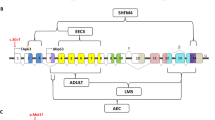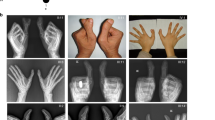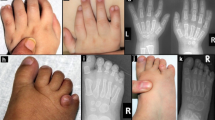Abstract
Tricho-rhino-phalangeal syndrome type I (TRPS I, MIM 190350) is a malformation syndrome characterized by craniofacial and skeletal abnormalities and is inherited in an autosomal dominant manner1. TRPS I patients have sparse scalp hair, a bulbous tip of the nose, a long flat philtrum, a thin upper vermilion border and protruding ears. Skeletal abnormalities include cone-shaped epiphyses at the phalanges, hip malformations and short stature. We assigned TRPS1 to human chromosome 8q24. It maps proximal of EXT1, which is affected in a subgroup of patients with multiple cartilaginous exostoses and deleted in all patients with TRPS type II (TRPS II, or Langer-Giedion syndrome, MIM 150230; ref.2–5). We have positionally cloned a gene that spans the chromosomal breakpoint of two patients with TRPS I and is deleted in five patients with TRPS I and an interstitial deletion4,6. Northern-blot analyses revealed transcripts of 7 and 10.5 kb. TRPS1has seven exons and an ORF of 3,843 bp. The predicted protein sequence has two potential nuclear localization signals and an unusual combination of different zinc-finger motifs, including IKAROS-like and GATA-binding sequences. We identified six different nonsense mutations in ten unrelated patients. Our findings suggest that haploinsufficiency for this putative transcription factor causes TRPS I.
This is a preview of subscription content, access via your institution
Access options
Subscribe to this journal
Receive 12 print issues and online access
$209.00 per year
only $17.42 per issue
Buy this article
- Purchase on Springer Link
- Instant access to full article PDF
Prices may be subject to local taxes which are calculated during checkout




Similar content being viewed by others
References
Giedion, A., Burdea, M., Fruchter, Z., Meloni, T. & Trosc, V. Autosomal dominant transmission of the tricho-rhino-phalangeal syndrome. Report of 4 unrelated families, review of 60 cases. Helv. Paediatr. Acta 28, 249–259 (1973).
Lüdecke, H.-J., et al. Molecular dissection of a contiguous gene syndrome: localization of the genes involved in the Langer-Giedion syndrome. Hum. Mol. Genet. 4, 31–36 ( 1995).
Hou, J., et al. A 4-megabase YAC contig that spans the Langer-Giedion syndrome region on human chromosome 8q24.1: use in refining the location of the trichorhinophalangeal syndrome and multiple exostoses genes (TRPS1 and EXT1). Genomics 29, 87–97 ( 1995).
Lüdecke, H.-J. et al. Genes and chromosomal breakpoints in the Langer-Giedion syndrome region on human chromosome 8. Hum. Genet. (in press).
Ahn, J., et al. Cloning of the putative tumour suppressor gene for hereditary multiple exostoses (EXT1). Nature Genet. 11, 137–143 (1995).
Nardmann, J., Tranebjærg, L., Horsthemke, B. & Lüdecke, H.-J. The tricho-rhino-phalangeal syndromes: frequency and parental origin of 8q deletions. Hum. Genet. 99, 638– 643 (1997).
Kozak, M. Initiation of translation in prokaryotes and eukaryotes. Gene 234, 187–208 (1999).
Jarrousse, A.S., Petit, F., Kreutzer-Schmid, C., Gaedigk, R. & Schmid, H.P. Possible involvement of proteasomes (prosomes) in AUUUA-mediated mRNA decay. J. Biol. Chem. 274, 5925–2930 (1999).
Dai, K.S. & Liew, C.C. Characterization of a novel gene encoding zinc finger domains identified from expressed sequence tags (ESTs) of a human heart cDNA database. J. Mol. Cell. Cardiol. 30, 2365–2375 (1998).
Brown, K.E. et al. Association of transcriptionally silent genes with IKAROS complexes at centromeric heterochromatin. Cell 91, 845–854 (1997).
Sun, L., Liu, A. & Georgopoulos, K. Zinc finger-mediated protein interactions modulate Ikaros activity, a molecular control of lymphocyte development. EMBO J. 15, 5358–5369 ( 1996).
Boulikas, T. Putative nuclear localization signals (NLS) in protein transcription factors . J. Cell. Biochem. 55, 32– 58 (1994).
Pehlivan, T. et al. GATA4 haploinsufficiency in patients with interstitial deletion of chromosome region 8p23.1 and congenital heart disease. Am. J. Med. Genet. 83, 201–206 (1999).
Kalff-Suske, M. et al. Point mutations throughout the GLI3 gene cause Greig cephalopolysyndactyly syndrome. Hum. Mol. Genet. 8, 1769–1777 (1999).
Fisher, E. & Scambler, P. Human haploinsufficiency—one for sorrow, two for joy. Nature Genet. 7, 5–7 (1994).
Ioannou, P.A. et al. A new bacteriophage P1-derived vector for the propagation of large human DNA fragments. Nature Genet. 6, 84–89 (1994).
Glöckner, G. et al. Large-scale sequencing of two regions in human chromosome 7q22: analysis of 650 kb of genomic sequence aound the EPO and CUTL1 loci reveals 17 genes. Genome Res. 8, 1060–1073 (1998).
Antonarakis, S.E. & the Nomenclature Working Group Recommendations for a nomenclature system for human gene mutations. Hum. Mut. 11, 1–3 (1998).
Yi, Y. et al. The ancestral gene for transcribed, low-copy repeats in the Prader-Willi/Angelman region encodes a large protein implicated in protein trafficking, which is deficient in mice with neuromuscular and spermiogenic abnormalities. Hum. Mol. Genet. 8, 533–542 (1999).
Acknowledgements
We thank the patients and their clinicians; S. Gro β, M. Klutz and S. Rothe for technical assistance; U. Claussen, B. La Pillo, J. Nardmann, M. Wagner and D. Wells for collaboration during initial stages of this project; D. Lohmann for help with the artwork; and E. Passarge for continuous support. Part of this research was supported by the Deutsche Forschungsgemeinschaft and the Bundesministerium für Bildung, Wissenschaft, Forschung und Technologie.
Author information
Authors and Affiliations
Corresponding author
Rights and permissions
About this article
Cite this article
Momeni, P., Glöckner, G., Schmidt, O. et al. Mutations in a new gene, encoding a zinc-finger protein, cause tricho-rhino-phalangeal syndrome type I. Nat Genet 24, 71–74 (2000). https://doi.org/10.1038/71717
Received:
Accepted:
Issue Date:
DOI: https://doi.org/10.1038/71717
This article is cited by
-
Long non-coding RNA KCNQ1OT1 promotes cell viability and migration as well as inhibiting degradation of CHON-001 cells by regulating miR-126-5p/TRPS1 axis
Advances in Rheumatology (2021)
-
Molecular genetic analysis and growth hormone response in patients with syndromic short stature
BMC Medical Genomics (2021)
-
Dual molecular diagnosis of tricho-rhino-phalangeal syndrome type I and Okur-Chung neurodevelopmental syndrome in one Chinese patient: a case report
BMC Medical Genetics (2020)
-
Der Hippo-Signalweg in der Regeneration und im Krebs
BIOspektrum (2020)
-
Rapid screening of copy number variations in STRC by droplet digital PCR in patients with mild-to-moderate hearing loss
Human Genome Variation (2019)



